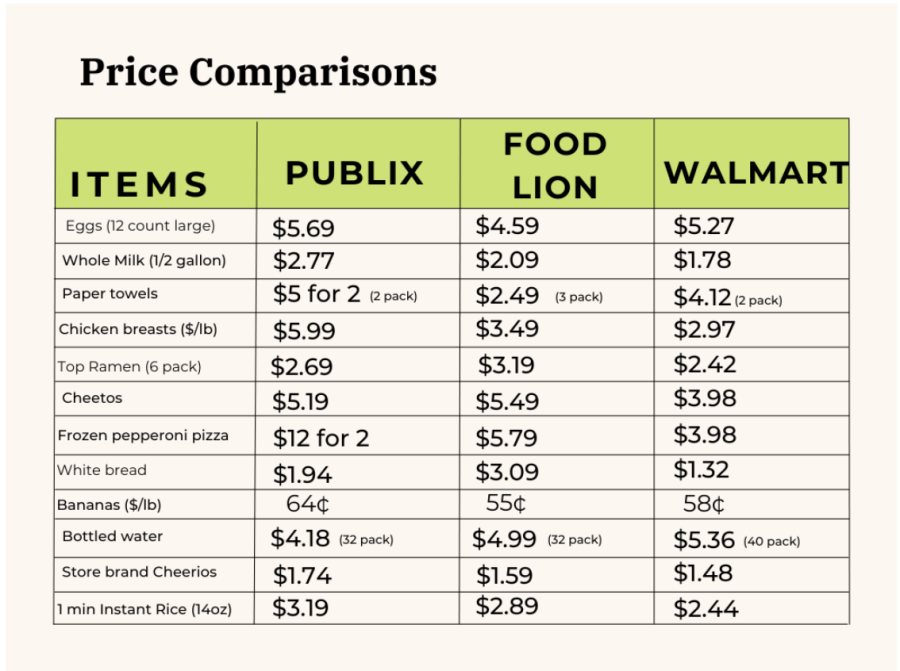You walk into the Recreation Activities Center and wander towards the free weights section. As you walk you are affronted with flying sweat and loud grunts. You observe people on a raised platform throwing loaded barbells overhead. People with bars loaded with double, or even triple, the weight of the athlete on their backs and squatting down. Another grunt resounds and turning you watch a person bring another bar filled with weights down to their chest, only to push it back off again. It seems near insanity that a person could, or should, be doing such movements with such heavy weights.
Olympic Weightlifting, or Weightlifting, and Powerlifting are widely misunderstood sports. Most people view them as unhealthy and dangerous, but a growing number of Georgia Southern University students are drawn to these heavy lifting sports.
Movements
Weightlifting consists of two competition lifts, the Clean and Jerk, which is a two-stage lift, and the Snatch. The Clean begins with the bar on the ground. The athlete pulls the bar from the ground, extending the body fully and quickly pulling him or herself under to catch the bar on the shoulders in a front squat. The Jerk is performed by using a quick dip and drive to push the bar overhead in a quick, fluid movement. The snatch is one smooth movement. The bar begins on the ground and is pulled from the ground, with the athlete extending completely and pulling themselves under the bar so that they catch the bar overhead. There are “power” versions of each lift, where the hips do not pass below the knee in the squat portion of the lift. This is where confusion between Weightlifting and Powerlifting can occur.
Powerlifting consists of three competition lifts: the squat, the deadlift and the bench press. The squat is the most basic of Powerlifting movements. A bar is loaded with weight and placed on the back and the person squats down until below parallel and stands. The deadlift is performed by gripping the barbell and pulling until the knees, hips and ankles are fully extended. The bench press is completed by positioning oneself on a horizontal bench and bringing the weight down to the chest and pressing it back to the original position.
Finding the sport
People find these two sports in various ways and for different reasons. In many cases, students find the sport from having done weightlifting in high school for other sports.
James Rowe, sophomore pre-athletic training major, has been lifting since eighth grade for football training.
He began to play football when he was eight and planned to try to go to college for football until he needed wrist surgery. Since he could no longer continue his football career, Rowe focused on lifting. The Show of Strength competition held at the RAC every year hooked his interests and so he began training. Since that competition Rowe has competed in roughly three others, including the World Natural Powerlifting Federation (WNPF) USA championships this past July.
Other competitors stumble upon lifting through their high school physical education and body conditioning classes.

Lifting since 2008 and a certified USA Weightlifting coach since 2012, David Purser, second year graduate exercise science student, is one of those competitors.
The weight training class Purser took in high school had a coach who was very fond of the Olympic lifts. Discovering that he enjoyed these lifts the most, Purser found a team in his hometown to continue training and competing with. He began training in January 2008 and did his first competition in the fall of that very same year.
“I wanted to get the certification because I was already a personal trainer and to make me a better trainer I figured having the credentials of an Olympic Weightlifting coach would be helpful,” Purser said.
Since becoming competitive in Weightlifting, Purser has won the Jr. Olympics in 2009 held in Iowa, medaled in the Jr. Olympics in 2010 and was one lift short of the bronze medal at the University National Championships in 2013 held in East Tennessee State.
“Most local competitions are pretty small so a lot of times I’ll be the only person in my weight class. So technically I win those too but I’m not really beating anybody,” Purser said.
Some athletes jump between the different weight lifting sports through an interest that sprouted from their high school experiences.
“When I was in high school you go to PE and you had the body conditioning class. With the girls something just didn’t feel right, so I moved up to the guys’ class,” Miranda Price, junior exercise science major, said. “So that is where I got into the Powerlifting. I found out I was really strong in my legs.”
Price was with one other girl in an all guys body conditioning class, and the two females pushed each other throughout the class and would try to match the guys in their weights. Since Powerlifting, Price has flirted with Bodybuilding and is now focused on Weightlifting.
Other athletes, like Gemma Skuraton, first year doctoral student, came upon the sport through certification. Falling in love with the sport, she began training and got her certification in order to better help her clients as a personal trainer. Since then she has been competing for about two years.

Fueling the athlete
As with any athlete, food and diet are key factors in overall performance. Weightlifters and Powerlifters are no different.
“There is a lot of meat. I would say that Weightlifters, Powerlifters, Bodybuilders, people who do Strongman, people who do those sports have a much higher protein requirement than other athletes or general population,” Purser said.
“No one thinks that we have to eat right or anything; nobody thinks that it takes a lot of work to do Powerlifting,” Rowe said. “Powerlifting is something that you have to do 24/7. You can’t go and say you are going to lift weights and then you can’t eat right.”
Some athletes tend to be stricter on their diets than others, depending on what works best for their training.
“I usually eat every two hours,” Skuraton said. “The majority of what I eat is protein, followed by fats, followed by carbs.”
Meal prepping is a key component in sticking to Skuratons’ diet. Having prepped meals for so long, Skuraton claims she can prep almost a month’s worth of meat in one Sunday. “If you can handle several hours in the kitchen on a Sunday you are good for a good month.”
The closer a competition gets, some athletes may begin to change their diets.
Purser begins to start cutting weight about three weeks away from a competition so that he can meet his weight class. Depending on how much he needs to cut in order meet that weight class is how strict he will be with his cutting diet.
“Right now I am about 11 weeks out from my next competition, so I am just starting my meet phase,” Rowe said. “I lift in the 242 [weight class] and before I worked out I weighed in at 259. So, the next couple weeks I will cut.”
“The week before the meet, I could drop on average about 15 pounds in a week. And some guys are really good and they can dehydrate their body really good for a meet and they can lose up to 25 pounds in 24 hours.”
Many people consider this rapid weight loss unhealthy but according to Rowe, if it is done correctly it is not harmful. Most meet weigh-ins are held on the Friday and the lifting is done on the Saturday. So between the weigh-in and lifting, Rowe can gain back most of the weight lost.
Training with weights
After diet, the actual training is the next factor in success for Weightlifting and Powerlifting. The athlete’s style of training determines their number of training days and whether they do their own programming or follow another prescribed program schedule.
“I personally train four times a week,” Purser said.
Each day that Purser trains, he has a set focus for that day. He will do one lift a day to focus all of his energy on perfecting that lift. One day he might work on snatch and then do accessory work that helps the snatch. The next day he would do the clean and jerk and accessory work focused on improving that lift. Throughout his training days, he will incorporate squat work, usually two to three times a week, because each lift has some variation of the squat worked on.
Rowe, on the other hand, follows the Lillibridge program. This program was created by an actual powerlifter where for three days he will work on the Powerlifting movements and the other three days he will do what he wants such as cardio, bicep and calf work and any other accessory movements.
Keeping that Drive
Long days in the gym with no visible results can be disheartening and so remaining motivated is a strong factor in maintaining performance within the sport.
“I like the feeling of being strong and I don’t like someone being able to tell me I can’t do something,” Price said. “I am going to prove you wrong, especially when it comes to weight. It might take me a while but I will get there.”
Knowing that he hasn’t met his potential yet is what keeps Purser going through the rough days. “Just knowing that if I did [quit] then I would probably regret not staying with it and seeing how far I could have taken it.”
Misconceptions Surrounding the Sport
There are many misconceptions that surround these two sports that tend to scare people away from trying them out.
The biggest misconception most athletes would have to agree on is that women believe lifting weights will make them bulky.
“Women don’t have the hormones for that to even be possible,” Purser said. “There are some very rare exceptions but for the most part women cannot physically gain enough muscle for them to look like a man.”
“You can build muscle and lose weight and still look really good,” Price said.
Another misconception is that Weightlifting and Powerlifting are dangerous.
“It is actually one of the more safer sports and I can speak to that from athletic training. The injury rate is very low,” Skuraton said. She claims that though chronic injuries are the most common of injuries in the sports, she sees more chronic injuries from running than Weightlifting.
“There are actually fewer injuries in Weightlifting than in any other sport, and that has been published and documented and researched; that isn’t just anecdotal evidence it’s the truth,” Purser said.
Steroids and illegal substance abuse is another common misconception surrounding Weightlifting and Powerlifting.
“If you go to national level meets they will drug test you,” Skuraton said. “They are strict; we even have restricted supplements, such as caffeine, if you are over that limit, you are popped for steroids.”
People think that the only way to get that big and strong is to do illegal substances, when really it’s just hard work, Rowe said.
Future aspirations
Though still just in college, the future is just around the corner. Fitness is still a priority when you have a full-time, adult job. And whether Weightlifting and Powerlifting is a continued sport is dependent upon the athlete themselves.
“I’ve kind of gone through all three phases,” Price said. “I want to do everything, I want to be everything. I want to be that 80-year-old group fit instructor still going. It’s more of a habit to lift. So, I won’t give it up. Whether or not I will still be competing I don’t know.”
“I would like to go world championships and I have hopes to become a sponsored athlete,” Rowe said.
Advice for aspiring weightlifters
People who see these athletes training at the RAC might become intrigued and wish to give these sports a whirl. For those that do wish to begin this weighted journey, there are some tips to follow.
“Find a coach who knows what they are doing and listen to them,” Purser said. Technology being the way it is, there are many people posting information on Facebook and Instagram on topics that they are not informed about.
There will also be good days and bad days, Purser warns. “You aren’t going to break your records every time you walk in the gym and that that is OK. You can still have a good workout without hitting a PR (personal record).”
Don’t be afraid to ask for help from people who work at the gym you are attending or from some of the other people working out in the gym, Price said.
“[Powerlifting] will let you reach limits that you have potential for that you could never reach before you tried it,” Rowe said.
Skuraton said, “If you have a body you are an athlete. It is not bound by age, it is not bound by talent, it is not bound by skill level. You have the capability to be an athlete and if you are not lifting weights, whether you are a male or a female, you are hindering your ability to be the best you can be.”
I feel like we should mention that she has changed sports or else the transition about jumping sports doesn’t make sense. and it’s just interesting that she has gone through all three.






